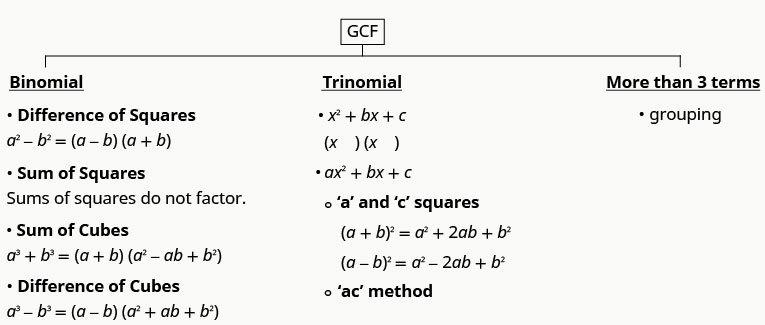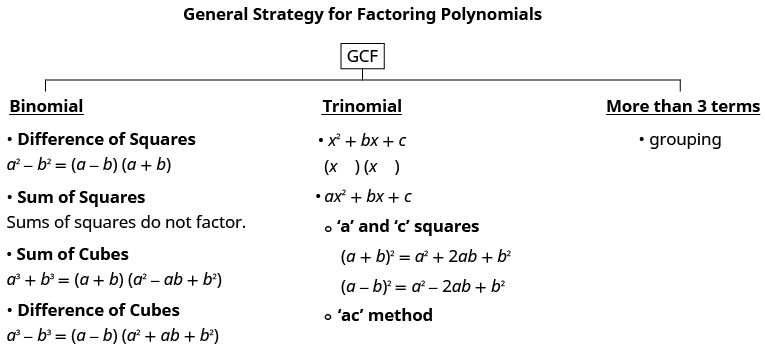6.5: General Strategy for Factoring Polynomial Expressions
( \newcommand{\kernel}{\mathrm{null}\,}\)
By the end of this section, you will be able to:
- Recognize and use the appropriate method to factor a polynomial completely
Recognize and Use the Appropriate Method to Factor a Polynomial Completely
You have now become acquainted with all the methods of factoring that you will need in this course. The following chart summarizes all the factoring methods we have covered, and outlines a strategy you should use when factoring polynomials.

- Is there a greatest common factor?
Factor it out. - Is the polynomial a binomial, trinomial, or are there more than three terms?
If it is a binomial:- Is it a sum?
Of squares? Sums of squares do not factor.
Of cubes? Use the sum of cubes pattern. - Is it a difference?
Of squares? Factor as the product of conjugates.
Of cubes? Use the difference of cubes pattern.
- Is it of the form
- Is it of the form
If a and c are squares, check if it fits the trinomial square pattern.
Use the trial and error or “
- Use the grouping method.
- Is it a sum?
- Check.
Is it factored completely?
Do the factors multiply back to the original polynomial?
Remember, a polynomial is completely factored if, other than monomials, its factors are prime!
Factor completely:
Solution
Factor completely:
- Answer
-
Factor completely:
- Answer
-
Be careful when you are asked to factor a binomial as there are several options!
Factor completely:
Solution
Factor completely:
- Answer
-
Factor completely:
- Answer
-
The next example can be factored using several methods. Recognizing the trinomial squares pattern will make your work easier.
Factor completely:
Solution
Factor completely:
- Answer
-
Factor completely:
- Answer
-
Remember, sums of squares do not factor, but sums of cubes do!
Factor completely
Solution
Factor completely:
- Answer
-
Factor completely:
- Answer
-
When using the sum or difference of cubes pattern, being careful with the signs.
Factor completely:
Solution
| Is there a GCF? Yes, 3. |  |
| Factor it out. |  |
| In the parentheses, is it a binomial, trinomial, of are there more than three terms? Binomial. |
|
| Is it a sum or difference? Sum. | |
| Of squares or cubes? Sum of cubes. |  |
| Write it using the sum of cubes pattern. |  |
| Is the expression factored completely? Yes. |  |
| Check by multiplying. |
Factor completely:
- Answer
-
Factor completely:
- Answer
-
Factor completely:
Solution
Factor completely:
- Answer
-
Factor completely:
- Answer
-
Factor completely:
Solution
Factor completely:
- Answer
-
Factor completely:
- Answer
-
Taking out the complete GCF in the first step will always make your work easier.
Factor completely:
Solution
Factor completely:
- Answer
-
Factor completely:
- Answer
-
When we have factored a polynomial with four terms, most often we separated it into two groups of two terms. Remember that we can also separate it into a trinomial and then one term.
Factor completely:
Solution
Factor completely:
- Answer
-
Factor completely:
- Answer
-
Key Concepts

- How to use a general strategy for factoring polynomials.
- Is there a greatest common factor?
Factor it out. - Is the polynomial a binomial, trinomial, or are there more than three terms?
If it is a binomial:
Is it a sum?
Of squares? Sums of squares do not factor.
Of cubes? Use the sum of cubes pattern.
Is it a difference?
Of squares? Factor as the product of conjugates.
Of cubes? Use the difference of cubes pattern.
If it is a trinomial:
Is it of the form
Is it of the form
If a and c are squares, check if it fits the trinomial square pattern.
Use the trial and error or “
If it has more than three terms:
Use the grouping method. - Check.
Is it factored completely?
Do the factors multiply back to the original polynomial?
- Is there a greatest common factor?


